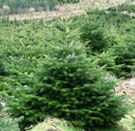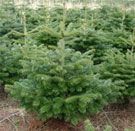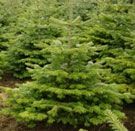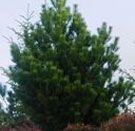Fresh real Christmas trees may be purchased from retail lots or choose & cut farms. When purchasing a cut tree, the freshness
depends on the care the trees have received. Pay attention to the manner in which the trees are stored and displayed. For example, are they stored under shade, displayed standing in water or misted at night? If so, the lot operator is working hard to keep the trees as fresh as possible.
One simple test for freshness is to gently grasp a branch between your thumb and forefinger and pull it towards you. If very few needles come off in your hand the tree is fresh. Shake or bounce the tree on its stump. You should not see an excessive amount of green needles fall to the ground. Some loss of interior brown needles is normal and will occur over the lifetime of a tree.
Make a cut of the bottom of the trunk one half inch from the bottom, many farms and lot operators will do this for you. The stand you use should at least hold one quarter of water for ever inch diameter of the trunk once the tree is in the stand. For example, a typical six Foot tall tree will have a four inch diameter trunk so the stand should at least hold four quarters (1 Gallon) after the tree is set up.
Beware of tree care myths
Misinformation about proper tree care can reduce the enjoyment of a real Christmas tree. Unfortunately, many well-intended, but poorly informed sources spread ineffective home remedies that have no scientific basis. The following questions represent some of the more common myth’s. The answers are based on extensive tree keepability research at several university and experiment stations.
Is it ok to buy a tree that is loosing its needles?
Some natural drop of older, interior is natural and normal. However, if the colour is faded, the bark of the outer twigs is wrinkled and the green, exterior needles easily fall of at a gentle touch or when the tree is bounced on a hard surface, it is excessively dry.
Is a fresh cut really necessary before putting a tree in a water stand?
Always make a fresh cut if possible. After time, the stump gets a crusty sap seal and air in the water vessels, which lessens a trees water absorption capacity. A fresh cut will reopen the pores and plant tissue that take up water.
How much should I cut off?
Only one and half inch is necessary, not one or two inch’s as is sometimes instructed.
Will tapering the base or cut it on a angle increase the area that takes up water?
No. the most efficient water transporting cells are just below the bark. Once the water levels fall below the exposed surface on a tapered trunk, drying will begin. An angle or “V” cut will require more water depth to cover the cut surface. It also makes the tree more difficult to stand upright.
Should I add bleach, aspirin, fertilisers or any other things to the water to make the tree last longer?
No. research has shown that plain tap water is the most consistent method to maintaining moisture levels across all species of trees. Water holding stands that are kept filled with plain water will extend the freshness of the tree for weeks.
How large should my water stand be?
Choosing a large capacity stand is one of the most important steps to maintaining the trees freshness. Avoid small “coffee cup” stands. Check the water level frequently since trees can drink large amounts of water each day, particularly pre-cut trees during the first week of display. Generally, a tree can use up to one quart of water per day for each inch of stem diameter. Therefore, a stand that will hold a four inch trunk should hold at least one gallon of water with the tree in the stand.






